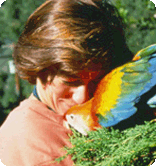Introducing parrots to each other

Hello Phoebe, I would like to know what approach is best taken when introducing parrots to each other. I have an African Grey and have bought a baby Myers Parrot that should be weaned in a few weeks time. My Grey Scooby is two and a half and very easy to handle as well as playful and has never been aggressive. I also have a cockatiel and he doesn’t show any signs of wanting to interact with him except when vocalizing?
Many thanks,
Ian

Hi Ian, Thanks for writing about your two African parrots and how to increase compatibility between them. The chances are great that they will like each other. The cockatiel provides his own voice to the chorus and is a nice member of your flock.
Please have the new bird’s health checked by your avian veterinarian before you bring him home. It makes good sense to protect the health of your current flock while confirming the health of the fledgling. Follow your vet’s recommended quarantine period.
The best tool you have for a smooth introduction and life-long friendship between your birds is your keen observation of their behaviors. You mention that Scooby is already playful, so you’re off to a great start. You’ve probably already shown him the baby’s new cage and enrichments, and told him about the happily anticipated arrival. Include Scooby in your preparations by telling him all about the baby, just like you would an older sibling of an expected human child.
Plan the logistics of the entry: have a safe place to set the baby down away from Scooby if Scooby seems distressed by the chick (He probably won’t—this is just a precaution.).
With a grey, you probably already have a whistle or other noise that you make back and forth to each other that signals “good bird” or “you’re cute” or “hi” or other types of approval. This communication will help you immeasurably when you introduce the two birds. Give Scooby the “happy sound” as you bring the chick into his view. Watch them both carefully and proceed slowly. If Scooby keeps responding to the happy sound, and the baby stays comfortable, move forward and keep watching.
Don’t go too far too soon.
It’s best to take the introduction one small step at a time. Stop and back up if Scooby or the baby starts to fidget uncomfortably or if one seems distressed. If all goes well, continue, but resist the urge to put the birds together beak-to-beak or within touching distance the first day. You’ll be able to gauge their relative comfort by tuning in to your own perceptions: if it feels like “enough,” it probably is. If you think one is uncomfortable, or if you are, slow down and stop the session.
Hopefully you, Scooby and the new bird will have many years to develop your mutual companionship, so relax into the process, have a good time and don’t force anything. If something goes awry, or if you have further questions, please don’t hesitate to write WPT again.
All best,
Phoebe Greene Linden

































